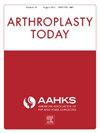Robotic Assistance is Associated With No Intraoperative Fluoroscopy or Radiation Exposure During Direct Anterior Total Hip Arthroplasty
IF 2.1
Q3 ORTHOPEDICS
引用次数: 0
Abstract
Background
As more total hip arthroplasty (THA) procedures continue to be performed and concomitant intraoperative fluoroscopic utilization continues to increase, it is important for surgeons to critically analyze this practice during their procedures. The direct anterior approach (DAA) is a popular technique, but often requires the use of fluoroscopy for evaluation of component positioning and implantation. Computed tomography (CT)–based robotic-assisted THA (RA-THA) may represent an alternative to conventional procedures, which may allow the avoidance of the use of intraoperative fluoroscopy to be avoided and instead rely on a preoperative CT scan of the patient and intraoperative mapping. The purpose of this study was to evaluate the difference in radiation exposure from CT-based RA-THA DAA vs fluoroscopy-guided conventional THA DAA based on values from a cadaver study.
Methods
There were 2 surgeons who had previous extensive experience with the DAA, as well as conventional and RA-THA. They completed bilateral direct anterior THAs on 6 cadaver specimens. For each cadaver, a conventional THA with fluoroscopy was performed on the first hip, and a robotically assisted THA without fluoroscopy was performed on the contralateral hip. For all robotic-assisted cases, a preoperative 3-dimensional CT was performed. The radiation dosage from the preoperative scan was acquired through the radiation dose structured reports. Radiation exposure dosage for intraoperative fluoroscopy required tabulation of the number of fluoroscopy shots performed for each case as well as the length of time of exposure. This time was then converted to an effective radiation dose based on accepted standards, and this was multiplied by the average number of fluoroscopy shots per case to determine the average dosage per case.
Results
No fluoroscopic images were taken during the RA-THA using the DAA. There was a mean of 21 ± 8.9 fluoroscopic shots taken during each fluoroscopy-guided conventional THA using the DAA. The minimum number of fluoroscopic shots was 9, with a maximum of 31. Total radiation exposure ranged from 300 to 1033 mrem, with an average of 700 mrem. The average radiation exposure for a hip CT scan was 289 mrem.
Conclusions
In this cadaver-based study, the use of a CT-based RA-THA DAA eliminated the need for intraoperative fluoroscopy, removing the concern of radiation exposure to the surgeon and surgical staff. The CT-based RA-THA DAA does require a preoperative CT scan of the patient; however, the radiation dosage to the patient was equivalent to 8.7 intraoperative fluoroscopy shots. As more surgeons, patients, and surgical staff are exposed to an increasing number of orthopaedic procedures that require ionizing radiation to generate images, such as fluoroscopy and CT, it is important to consider the radiation dosage for all individuals and understand the positives and negatives of each treatment. We must consider the overall long-term health impacts of continuous fluoroscopy vs a one-time CT scan. This is of particular importance to the surgeon and surgical staff who may be exposed to cumulative doses during multiple procedures.
机器人辅助与直接前路全髋关节置换术中无透视或辐射暴露相关
背景:随着越来越多的全髋关节置换术(THA)手术继续进行,术中透视术的应用也在不断增加,外科医生在手术过程中批判性地分析这种做法是很重要的。直接前路入路(DAA)是一种流行的技术,但通常需要使用透视检查来评估组件的定位和植入。基于计算机断层扫描(CT)的机器人辅助THA (RA-THA)可能是传统手术的一种替代方法,它可以避免术中透视检查的使用,而是依赖于患者的术前CT扫描和术中绘图。本研究的目的是评估基于ct的RA-THA DAA与基于透视引导的传统THA DAA在尸体研究值上的辐射暴露差异。方法有2位外科医生具有丰富的DAA、常规和RA-THA手术经验。他们完成了6具尸体标本的双侧直接前路tha。对于每具尸体,在第一个髋关节进行常规的有透视的THA,在对侧髋关节进行无透视的机器人辅助THA。对于所有机器人辅助的病例,术前进行三维CT检查。术前扫描的辐射剂量通过辐射剂量结构化报告获得。术中透视的辐射暴露剂量需要对每个病例进行的透视次数以及暴露时间的长度进行制表。然后根据公认的标准将这一时间转换为有效辐射剂量,并将其乘以每个病例的平均透视次数,以确定每个病例的平均剂量。结果在RA-THA过程中,DAA未拍摄x线图像。在每次使用DAA的透视引导下的常规THA中,平均有21±8.9次透视拍摄。最小透视次数为9次,最大为31次。总辐射暴露量为300至1033毫雷姆,平均为700毫雷姆。髋关节CT扫描的平均辐射暴露量为289毫雷姆。结论在这项以尸体为基础的研究中,使用基于ct的RA-THA DAA消除了术中透视的需要,消除了对外科医生和手术人员辐射暴露的担忧。基于CT的RA-THA DAA确实需要患者术前CT扫描;然而,对患者的辐射剂量相当于术中透视8.7次。随着越来越多的外科医生、患者和外科工作人员接触到越来越多需要电离辐射来产生图像的骨科手术,如透视和CT,考虑所有个体的辐射剂量并了解每种治疗的阳性和阴性是很重要的。我们必须考虑连续透视与一次性CT扫描对整体长期健康的影响。这对外科医生和外科工作人员尤其重要,因为他们可能在多次手术中暴露于累积剂量。
本文章由计算机程序翻译,如有差异,请以英文原文为准。
求助全文
约1分钟内获得全文
求助全文
来源期刊

Arthroplasty Today
Medicine-Surgery
CiteScore
2.90
自引率
0.00%
发文量
258
审稿时长
40 weeks
期刊介绍:
Arthroplasty Today is a companion journal to the Journal of Arthroplasty. The journal Arthroplasty Today brings together the clinical and scientific foundations for joint replacement of the hip and knee in an open-access, online format. Arthroplasty Today solicits manuscripts of the highest quality from all areas of scientific endeavor that relate to joint replacement or the treatment of its complications, including those dealing with patient outcomes, economic and policy issues, prosthetic design, biomechanics, biomaterials, and biologic response to arthroplasty. The journal focuses on case reports. It is the purpose of Arthroplasty Today to present material to practicing orthopaedic surgeons that will keep them abreast of developments in the field, prove useful in the care of patients, and aid in understanding the scientific foundation of this subspecialty area of joint replacement. The international members of the Editorial Board provide a worldwide perspective for the journal''s area of interest. Their participation ensures that each issue of Arthroplasty Today provides the reader with timely, peer-reviewed articles of the highest quality.
 求助内容:
求助内容: 应助结果提醒方式:
应助结果提醒方式:


